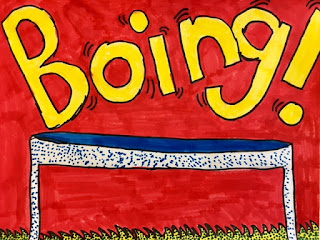The first country on our Arts Around the World journey this year is Mexico. We learned about Día de Muertos or Day of the Dead, a holiday celebrated in Mexico on November 1st and 2nd. Families gather to honor and remember friends and family members who have died.
Traditions include building altars to honor family members and decorating them with sugar skulls and marigolds, a kind of flower.
We watched a video about the holiday. The skull or calavera is a common symbol of the holiday. We looked at examples of sugar skulls and noticed that they had a symmetrical design and were usually very colorful.
We designed our own calaveras, creating a symmetrical design. First students used pencil to draw their designs and then outlined them with Sharpie marker. We added color using markers, trying to emphasize our symmetrical designs with our use of color.
For the background, we made papel picado, which translates to perforated paper. Papel picado is a form of Mexican folk art where tissue paper is cut into elaborate designs.
Papel picado is used to decorate for holidays, such as Day of the Dead, but also other celebrations such as birthdays and weddings.
Students used tissue paper and folded it up a few times before cutting out their shapes. We noticed that when we cut triangles and semi circles they became diamonds and full circles when cut on a folded edge, as they doubled.
Students carefully glued down their papel picado to a background color which they selected to complement their tissue paper color. They thought about what color background would allow their papel picado to stand out.
They then cut and glued their calavera designs and glued them on top of their papel picado backgrounds. Below are some examples of our our artwork. Some of our calavera designs are also currently on display near the art room.
 |
| Ava, 2nd Grade (O'Connor) |
 |
| Bianca, 2nd Grade (Hinds) |
 |
| Brook, 2nd Grade (Pearse) |
 |
| Carson, 2nd Grade (O'Connor) |
 |
| Jacob, 2nd Grade (Hinds) |
 |
| Naomi, 2nd Grade (Hinds) |
 |
| Samuel, 2nd Grade (O'Connor) |
 |
| Tyler, 2nd Grade (O'Connor) |
 |
| Willow, 2nd Grade (Hinds) |
 |
| Martin, 2nd Grade (Stone) |
 |
| Sarah, 2nd Grade (Stone) |
 |
| Tyler, 2nd Grade (Stone) |






















































